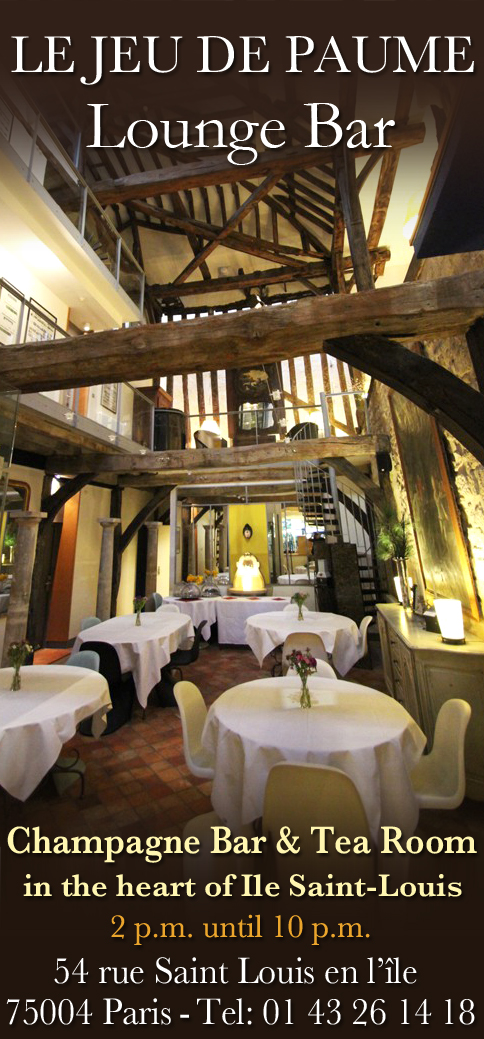 Places of Worship
Places of Worship
Cathédrale Notre-Dame de Paris
6 place du Parvis 75004 Paris
Tél. 01 42 34 56 10
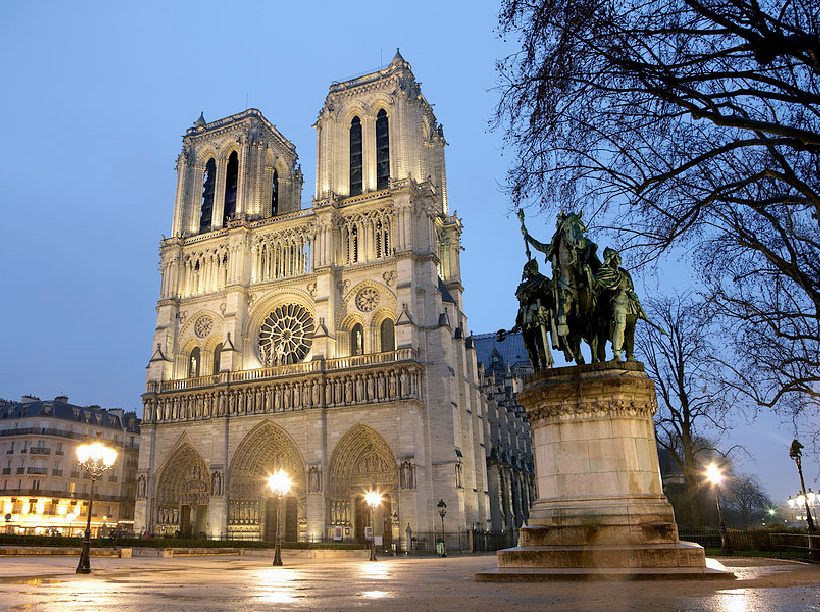
The construction of Notre Dame began in the 12th century and finished in the 14th century. Throughout the Middle Ages, Notre Dame educated the clergy as well as the elite of the kingdom. It won recognition due to the richness of its liturgy and the prestige of the relics it had. It is the symbol of the Gothic style, and was considerably ruined during the revolution by looting and destruction. Notre Dame was radically restored in the 19th century by the French architect Eugène Emmanuel Viollet-le-Duc. It remains today one of the most emblematic buildings in Paris, where faithful worshipers from around the world continue to demonstrate their devotion.
Weekend services- Saturday: 17h45: first Sunday Vespers services, 18h30: Sunday Mass at the main altar. Sunday: (all services are held at the main altar), 8h30: Mass, 9h30: lauds service, 10h00: Gregorian mass at the cathedral chapter, 11h30: international Mass, 12h45: Mass, 17h45: Vespers service, 18h30: Mass (usually chaired by the Archbishop) broadcast live on KTO-Catholic Television and Radio Notre Dame.
Weekdays, Monday to Saturday noon: 8h00: Mass in the choir, 9h00: Mass in the choir (except during the summer months: July, August and the first half of September), 12h00: Mass at the main altar, 17h45: Vespers service broadcast live on KTO-Catholic Television, 18.15: Mass at the main altar. Eucharistic Adoration: Every Thursday after Mass from 18h15 to 19h15. (except during the summer months: July, August and the first half of September).
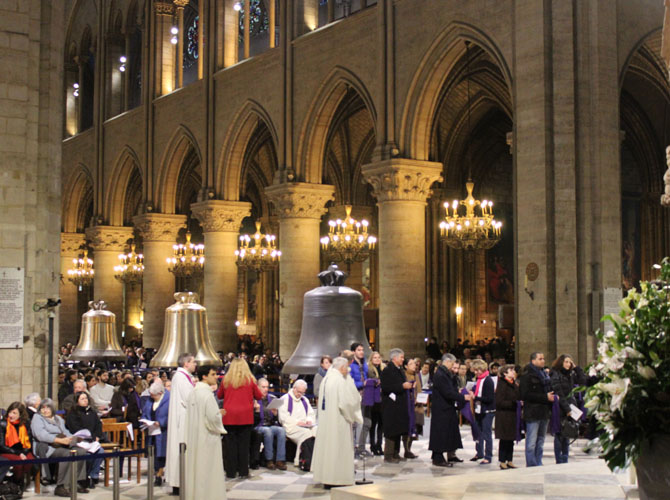
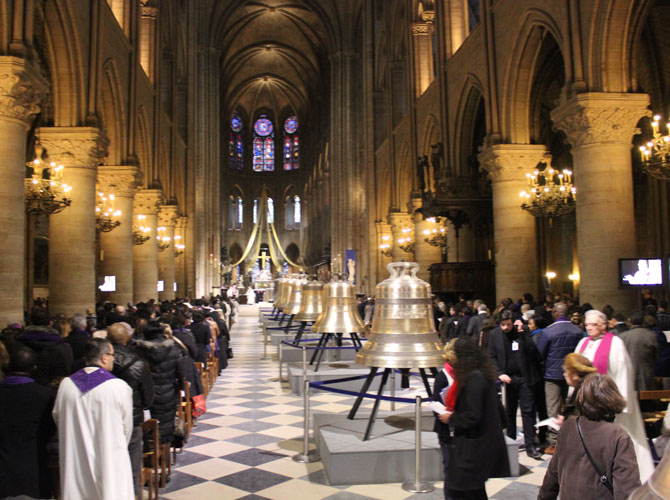
Veneration of the Crown of Thorns and the Relics of the Passion: Every first Friday of the month and every Friday during Lent at 15h00. On Good Friday, this veneration takes place throughout the day.
The treasure can be visited every day at the following times: Monday to Friday from 9:30 to 18:00, Saturday: from 9:30 to 18:30, Sunday from 13:30 to 18:30. These schedules can be modified according to special celebrations.
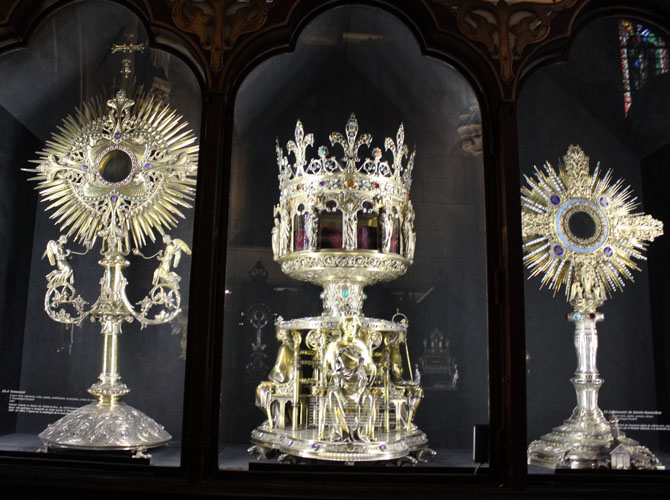
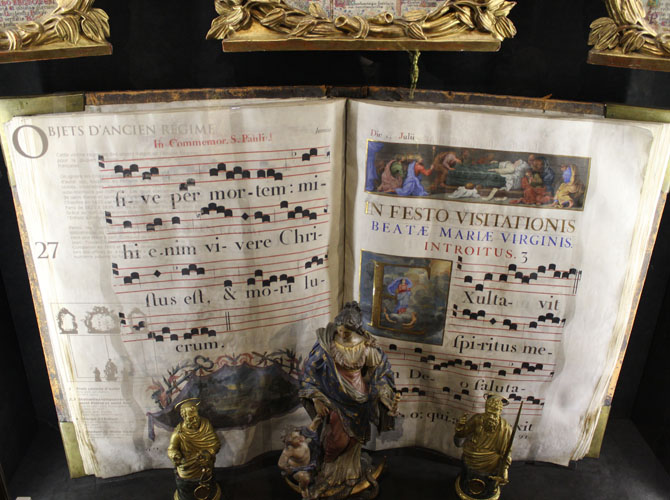
CHURCH OF NOTRE-DAME DES BLANCS MANTEAUX
1 rue de l'Abbé Migné 75004 Paris
Tél. 01 42 72 09 37
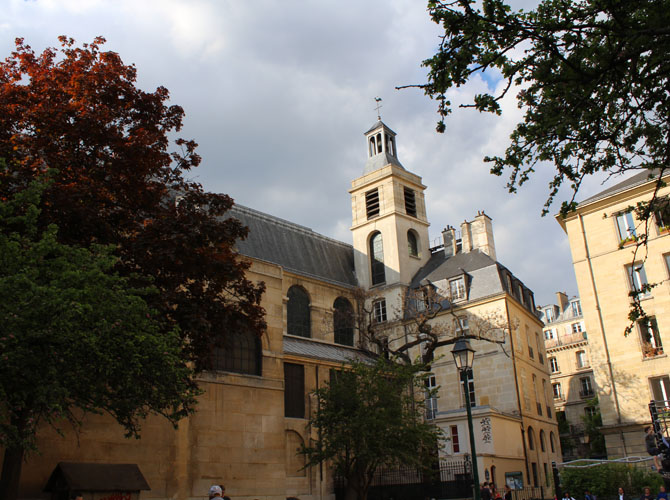
The begging order of the Servants of Mary established their monastery in the Church of Notre-Dame des Blancs Manteaux in 1258. As this religious order wore a coat of white wool, the French people nicknamed them “the White Coats”. In 1618, the monastery was reformed by the Benedictines of the congregation of St. Maur. During the Revolution, the convent and the church were both sold. Purchased by the city of Paris in 1801, the church was given back to the worshipers and became a parish church.
The plan of the church is rectangular. The interior is characterized by a beautiful oak chair of Bavarian origin, made in 1749, made of marquetry panels inlaid with precious wood, mother of pearl, and ivory, in a rococo style.
Masses are celebrated on Tuesday, Wednesday and Friday at 18:30 and on Thursday at 12:30. The Blessed Sacrament is celebrated on the first Friday of the month from 17:30 to 18:30. The Rosary is celebrated every day at 17h45 except on Friday.
THE CHURCH OF SAINT-GERVAIS-SAINT-PROTAIS
Monastic Fraternity of Jerusalem
13 rue des Barres 75004 Paris
Tel. 01 48 87 32 02
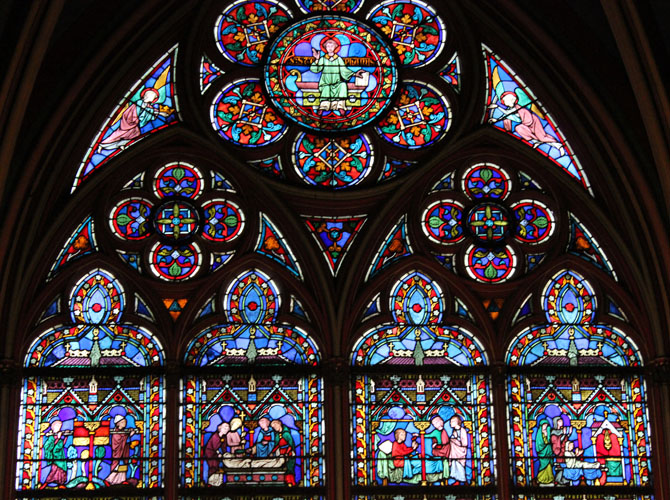
Saint Gervais was the first paris' church on the left bank in the 11th century, due to the large number of people who worshiped there and because the frequent floods made the approaches to the Pont au Change impassable, preventing people from accessing the Ile de la Cite. It was rebuilt in 1420 and consecrated by Jean Ogier de Gombauld, Bishop of Agrance. It was enlarged over the centuries and the work was completed in 1657. It is in the form of a Latin cross. The facade shows the three juxtaposed orders (Doric, Ionic, and Corinthian). It became the model for many buildings constructed in the 17th century, most notably the church of Saint Paul Saint Louis. The organ was long held in possession by several generations of the famous Couperin family. Sunday Mass is at 11h.
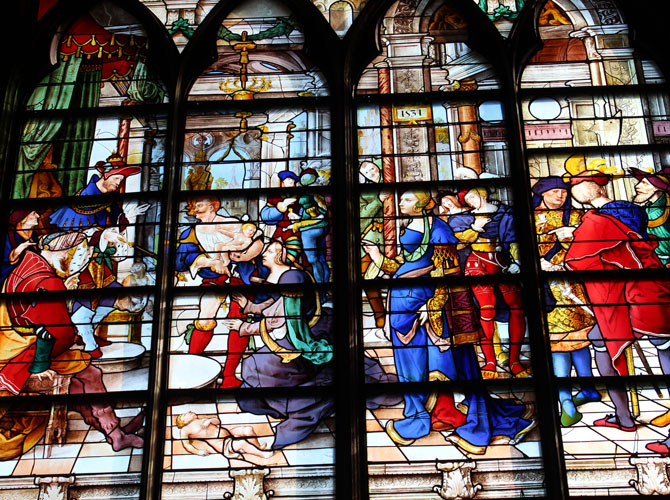
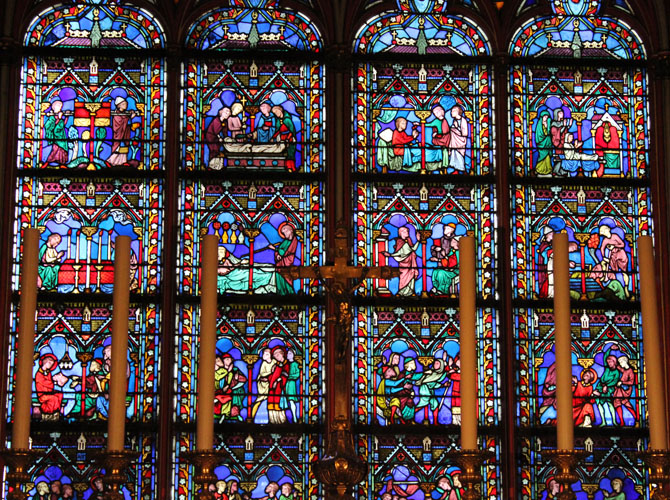
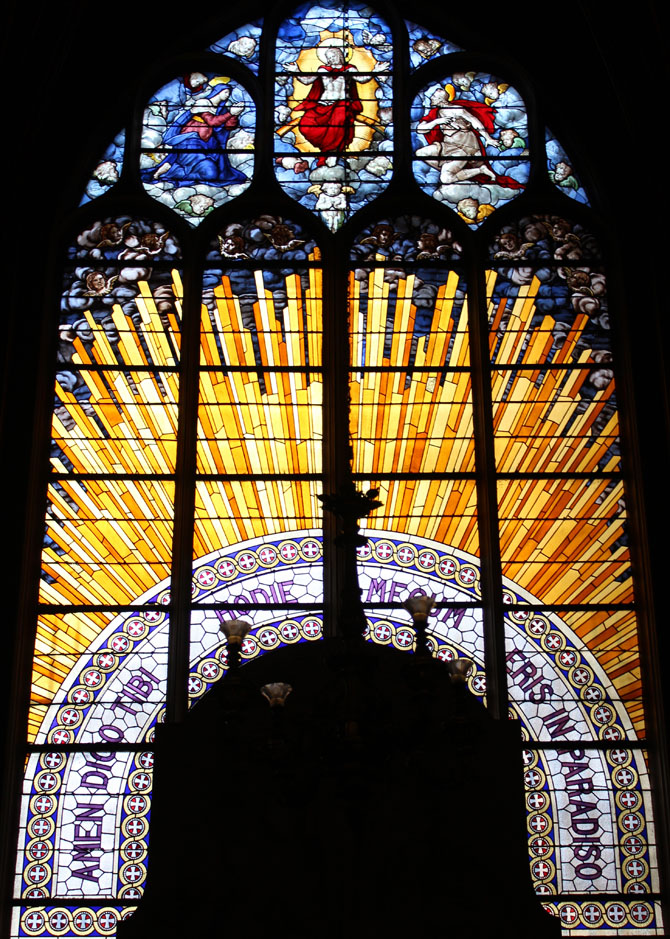
CHURCH OF SAINT-PAUL SAINT-LOUIS
7 passage Saint-Paul / 99 rue Saint-Antoine 75004 Paris
Tél. 01 42 72 30 32
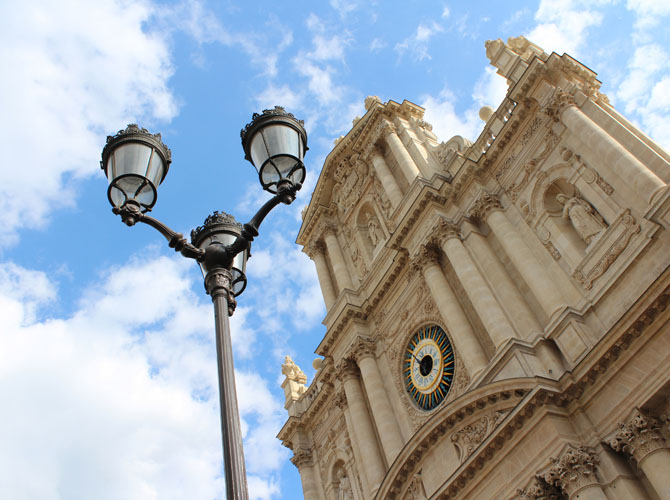
Richelieu celebrated the first Mass on May 9, 1641 in this church. The church was the center of Parisian religious life. Until the revolution, the church took the name of Saint Louis de la Couture Sainte Catherine. In 1790 the priory was eliminated. The church was given back to the worshipers in 1802 and became the new parish church of Saint Paul Saint Louis.
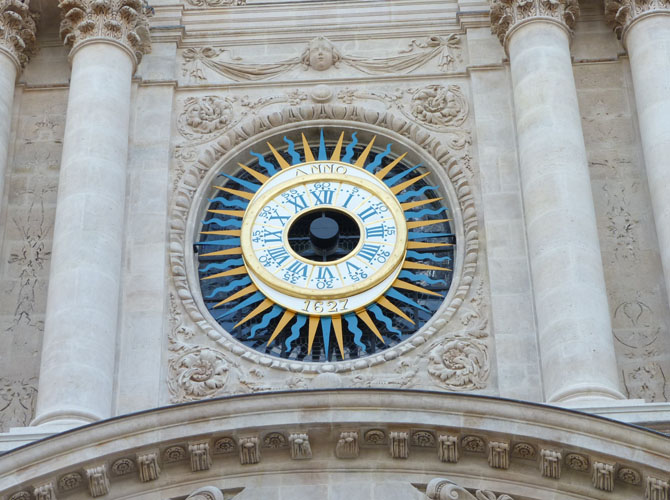
The plan of the church is inspired by the Church of the Gesù in Rome, built by Giacomo Barozzi da Vignola in 1560. The church is very bright and still quite decorated, although much of the furniture disappeared during the revolution. Among the treasures of the church, note the funeral chapel of Henry II de Bourbon, Prince de Conde. The facade has recently been restored, in 2012, giving it back its true luster and shine. The facade is the work of Derand, who was inspired by the church of Saint Gervais.
Mass schedule during the weekend: on Saturday 18h00 hosted by the Chaplaincy of the Marais, on Sunday at 9h30, on Sunday at 11h00, and Solemn Mass on Sunday at 19h.
Mass times during the week: from Tuesday to Saturday at 9h00 in the chapel, 9 passage Saint Paul, and from Monday to Friday at 19h in the church.
Pray to St. Paul: prayer (morning service sung) from Tuesday to Saturday from 8:30 to 8:50, Rosary on Wednesdays and Fridays from 16h30 to 17h, Adoration of the Sainted Sacrament from Tuesday to Friday from 17h to 19h, the Way of the Cross during the Fridays of Lent from 12h30 to 13h15.
Other information: The church is open from Monday to Friday from 8h00 to 20h, on Saturday from 8h00 to 19h30 and on Sunday from 9h to 20h. Reception by a priest and confessions from Tuesday to Friday from 17 to 19h, and on Saturday from 16h30 to 18h.
Eglise vieille catholique mariavite de Pologne
7 rue Aubriot 75004 Paris
Tél. 01 42 72 84 75
This church is located in a street that has retained its old character thanks to the surrounding houses from the 17th and 18th centuries.
Eglise Saint-Louis en l'Ile
3 rue Poulletier 75004 Paris
Tél. 01 46 34 11 60
This church was dedicated to St. Louis King of France, under the name of Louis IX from 1226 to 1270. The church Notre-Dame-en-l'île, renamed the Church of Saint-Louis in 1634, had its facade on the main street, and its choir facing to the south. After the island was fully built, the chapel was found to be too small. It therefore became an obligation to build a real parish church. The decision was taken on December 10, 1642, but financial difficulties forced him to wait until 1656 for the foundation work to begin.
The first stone was laid by Hardouin de Péréfixe de Beaumont on October 1 1664, the inaugurational blessing and the consecration of the altar was celebrated by François Harlay de Champvallon on August 20, 1679. Louis Le Vau had died in the meantime in 1676, and it was therefore Gabriel Le Duc (former architect of the Val-de-Grace) who finished the choir. On February 2, 1701, a hurricane destroyed the roof of the original building. It was necessary to complete the new church.
A royal lottery permitted the church to raise the necessary funds. The Duke died in 1702, and Pierre Bullet continued with the building plans, following the architectural logic of the choir. Cardinal Louis Antoine de Noailles laid the first stone in 1702. Jacques Doucet finished the nave in 1723, and completed the final plans of the transept and the dome, executed in 1725. The Bishop of Grenoble, Jean Collet, consecrated the church on July 14, 1726.
A bell tower was raised at the crossing of the transept, but it was destroyed by lightning in 1740 and replaced in 1765 by the current bell tower, shaped in a rather curious obelisk form.
The mass schedule in the parish of Saint Louis en l'Ile: The presence of a house Seminar of Paris and the vicinity of the College of the Bernardines create the possibility that there may be occasional celebrations outside of the parish schedules. These celebrations are announced separately.
Mass schedule- from Monday to Friday at 18h45, on Saturday (early Sunday Mass) at 18h30, and on Sunday Solemn Mass at 11h00.
EGLISE SAINT DENYS DU SAINT SACREMENT
68 bis rue de Turenne
Tel : 01 44 54 35 88
The city of Paris had the church of Saint Denys du Saint Sacrement erected in 1823 by the architect Hippolyte Godde, who was inspired by the early Christian basilica churches of Rome. The facade is characterized by a rhythmic gantry made up of 6 ionic columns, and covered with a ceiling decorated with rosettes. It is particularly inspired by the Holy Church Saint Philippe du Roule (75008). Inside, one should not miss a painting by Eugene Delacroix, the Testimony of the Cross (1844, on the right when entering).
Mass is celebrated on Sundays at 11h. Reception is open every day from Monday to Friday from 9h30 to 12h and 14h to 19h, and on Saturday from 9:30 to 12pm. The priest receives worshipers from 16h30 to 19h on weekdays. The Adoration of the Blessed Sacrament takes place on Fridays from 18h to 19h.
Eglise Saint-elisabeth de Hongrie
195 rue du Temple 75003 Paris
Tel : 01 49 96 49 10
Sainte-Elisabeth de Hongrie is the monastery church of the Order of Malta in Paris. This is why we see the Knights of Malta, wearing black coats marked with the characteristic cross their order, regularly attend Mass at St. Elizabeth. It is a hospitable and religious order placed directly under the authority of the Holy Father. The facade is classic with doric and ionic pilasters. Inside, the 100 bas-reliefs of carved wood that line the walkway are of great beauty and come from the Benedictine Abbey of St. Vaast in Arras. The organ, built in the 19th century by Marie-Antoine-Louis Suret includes all innovations of the Parisian romantic movement of the first half of the 19th century.
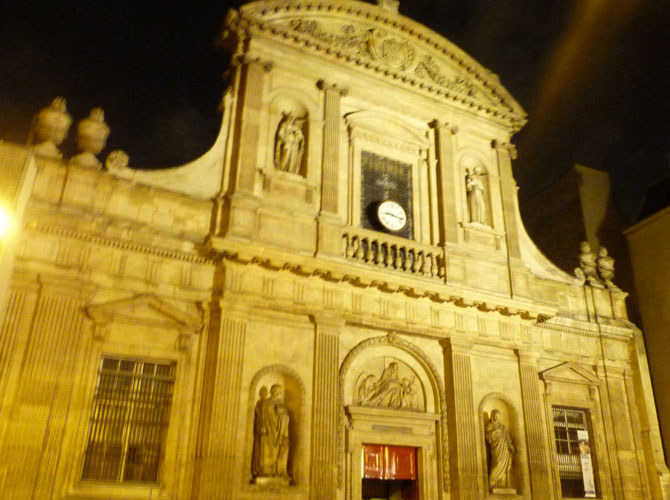
Sunday Mass- on Saturday at 18h30 and Sunday at 11h. Mass during the week at 12h30 from Tuesday to Saturday and at 19h from Tuesday to Saturday. The adoration of the Blessed Sacrament is from 17h to 18h30 on Tuesday and Thursday, and from 19h30 to 21h30 on Friday. The rosary is on Tuesday at 16:30. The church is open from 9h00 to 19h30 on weekdays and from 9h00 to 12h00 on Saturday.
Eglise Saint-Merri - Centre pastoral Halles-Beaubourg
76 rue de la Verrerie 75004 Paris
Tél. 01 42 71 93 93
Located near the Centre Pompidou, the foundations of the Church of Saint Merry date back to the early 16th century. Closed in 1793, it became a saltpeter factory. It was returned to the Catholic faith in 1803 and was the subject of the classification as a historical monument. Its architecture is of Gothic style and has retained no renaissance elements.
The Church of Saint Merry notably has an incredibly rich collection of paintings from the 17th to the 19th century:
- Pieta attributed to Nicolas Legendre 17th century,
- The adoration of the divine name by the four saints (left brace) by Simon Vouet in 1640,
- Virgin and Child, oil on canvas by Carle Van Loo, 1765 (altar right at the entrance of the choir)
- History of St. Mary the Egyptian, frescos by Theodore Chasseriau, from 1843 (the third chapel of the choir on the left side)
- Jesus and the Samaritan woman by Noel Coypel in approximately 1683.
The parish is open to the modern world and its culture. Mass is on Sunday at 10h00 and 11h15, as well as Saturday at 18h30. Coffee meet ups are organized at 13h15 every day. There are free concerts on Saturday at 20h and on Sunday at 16h. The David and Jonathan association holds talk time on the 2nd Friday of the month from 19:30 to 20:30.
PROTESTANT WORSHIP
EGLISE REFORMEE DU MARAIS
Temple Sainte-Marie
17 rue Saint-Antoine 75004 Paris
Tél. 01 42 74 40 82
At this location in the 14th century stood the Hotel de Culdoe, purchased in 1399 by Charles VI, who gave it to Jean de Montaigu. Jane Frances de Chantal, grandmother of Madame de Sevigne, found a home in Paris there around the 16th century. The convent was destroyed in the revolution. In 1802, the building was assigned to Protestant worship under the name of Temple Sainte Marie. Having suffered damage during the siege of 1871, the church was restored in 1874 by Marcellin Varcollier. The church has a rotunda of 13 meters in diameter, a sanctuary, and two side chapels. This arrangement recalls the chapel d'Anet due to Philibert de l'Orme. On the pediments, statues of charity (on the right) and religion (on the left) inspired by Michelangelo, were redone by Ernest-Eugène Hiolle in 1873. In the Church of the Visitation of St. Mary were notably buried Nicolas Fouquet, superintendent of finances of Louis XIV.
Sunday: 10h30 to 12h
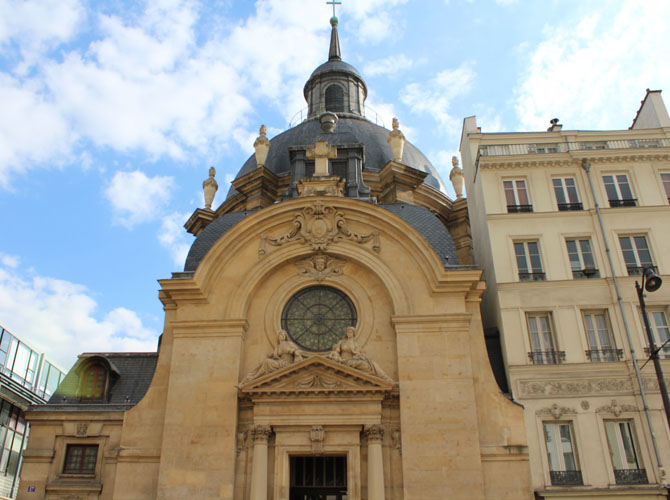
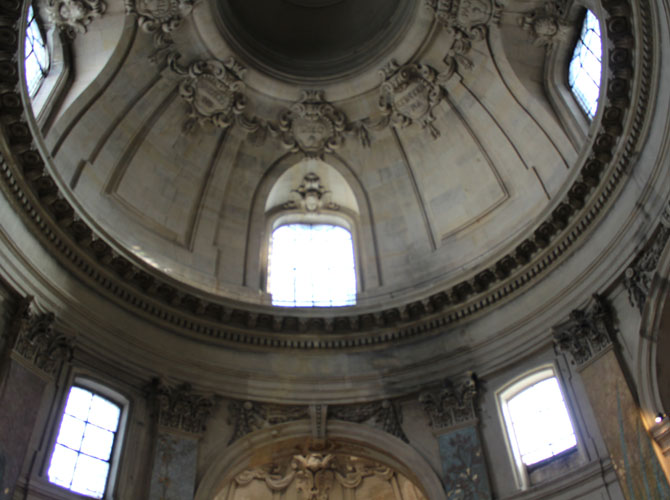
Eglise luthErienne des Billettes
22 rue des Archives 75004 Paris
Tél. 01 42 72 38 79
A chapel was entrusted to the Hospitaliers de la Charité Notre Dame, called Billettes, in 1299. The convent grew. A new church was rebuilt in 1408. In 1631, the reformed Carmelites, also called the Carmes-Billettes, made the acquisition of the convent. The church and convent were sold as national property in 1793 and 1795. In 1808, the city of Paris bought them and gave the church to Augsburg Lutheran worship.
The church has a nave of four bays, without a transept, with verges and a nearly circular choir. The facade is inspired by the Gesu. The flamboyant style of the cloister dating from 1427 is the only one preserved from the times of Medieval Paris. It is possible to observe some carved keystones, representing angels wearing a badge once having been that of the arms of France.
Worship: Sunday at 10h30, with Holy Communion except in the absence of an ordained pastor. Worship is preceded by an organ concert at 10h, except in July and August
.
Evening office: Thursday at 19h, Vespers sung with Holy Communion.
ORTHODOX WORSHIP
Eglise orthodoxe franCaise
30 boulevard de Sébastopol 75004 Paris
Tél. 01 42 78 24 03
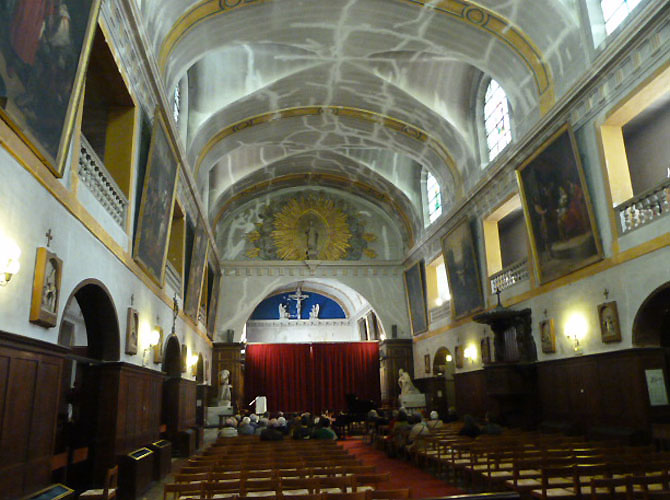
JEWISH WORSHIP
OUR LADY OF NAZARETH SYNAGOGUE
This synagogue is the oldest of the major synagogues in Paris. In 1810, the Parisian Jews of German descent (Ashkenazi) had two synagogues, one situated in rue Sainte-Avoye (now rue du Temple), and another, now defunct, in rue Chaulme (the current rue des Archives). Expelled from rue Sainte-Avoye in 1818, the community in 1819 acquired a piece of land located between the rue de Vertbois and the rue Notre-Dame-de-Nazareth. The Israelite Consistory of Paris built a synagogue according to plans by the architect Sandrié de Jouy. It was finally inaugurated in 1822. Building anomalies were soon detected, forcing its closure in 1850. It was then destroyed, and a new synagogue was rebuilt on the site according to the plans of the architect AlexandreThierry (1810-1890) thanks to the generosity of Baron James de Rothschild. The new synagogue was inaugurated in 1852.
It has an organ, which was revolutionary for its time. The actress Rachel and the composer Jacques Offenbach regularly attended services there. The rite is Alsatian and was actually the residence of the Great Rabbis of France and Paris until the construction of the Great Synagogue (the synagogue of the rue de la Victoire) in 1875.
During World War II, the synagogue was the victim of an attack in October of 1941. The Grand Rabbi of the synagogue, Joseph Saks, and his wife were arrested and then died in exile. Due to the influx of Jews from North Africa who settled in the neighborhood, the synagogue is now dedicated to Sephardic practices.
The Synagogue is the only Parisian synagogue with that of the rue des Tournelles to have two floors of galleries for women, supported by cast iron columns.
Opening hours: Monday to Friday from 9h00 to 13h00 and from 14h00 to 16h00. It is closed on Saturday and Sunday.
Synagogue Agoudas Hakehilos
10 rue Pavée 75004 Paris
Tél. 01 48 87 21 54
The synagogue stands on a high and narrow facade, in contast with the appearance of the surrounding buildings. It is characterized by long pillars (similar to those found on a building located at 10 rue de Bretagne 75003) and narrow windows. The synagogue, of art nouveau style, was realised by the architect Hector Guimard.
The whole building is constructed in length. The width of the monument is only 5 meters and its length is of 23 meters. The architect therefore had to use trickery to reflect the constraints of the configuration of the plot. The architecture is rather somber and "wavy", a little overwhelmed by the isolated feeling of the street.
This historic monument, as well as its furniture, is the last place of worship built in the Marais. It is the only one designed by Hector Guimard and the only one not dependant on the Consistory. It was inaugurated in 1914.
Synagogue
21bis rue des Tournelles 75004 Paris
Tél. 01 42 74 32 82
The synagogue was inaugurated on September 15, 1876, day of the Jewish New Year. The largely non-Jewish architects, given the task at the time of designing this place of worship, were inspired by churches but made references to Jewish symbolism by placing tables of the law at the top of the building. The interior recalls the churches of Saint-Eugène et Sainte Cecile (6 rue sainte cecile 75009). The nave of five bays, 21 meters wide, ends with a semicircle. Gustave Eiffel designed the internal metal frame, left exposed, iron and cast iron. The decor consists of palms, carved ram horns, of biblical inscriptions in Hebrew. Sephardic rites, morning and evening offices, Friday evening, Shabbat and holidays.
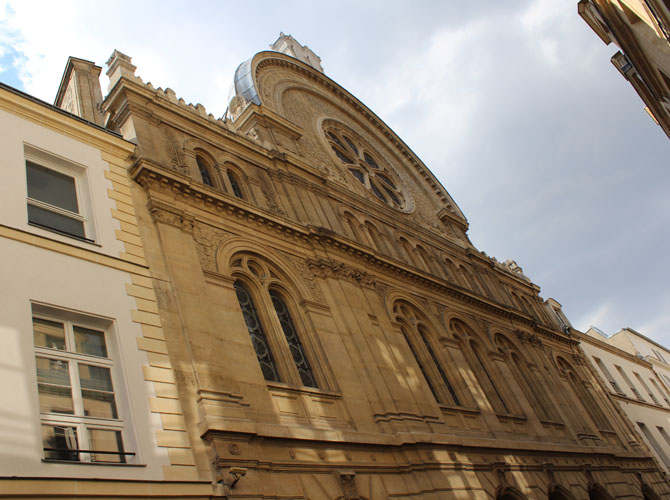
Synagogue Tephilat IsraEl Frank-Forter
24 rue du Bourg Tibourg 75004 Paris
Tél. 01 42 77 32 29
Synagogue Oratoire Mahzike Adath
Mouvement Loubavitch
17 rue des Rosiers 75004 Paris
Fondation Fleischmann - Synagogue
18 rue des Ecouffes 75004 Paris
Tél. 01 48 87 97 86
Synagogue Adath Lyechouroun
25 rue des Rosiers 75004 Paris
Tél. 01 44 59 82 36
Synagogue
Association Consistoriale Israélite de Paris - Temple des Vosges
14 place des Vosges 75004 Paris
Tél. 01 48 87 79 45
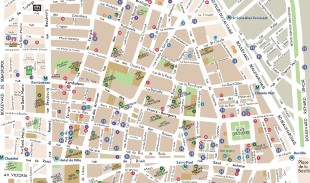
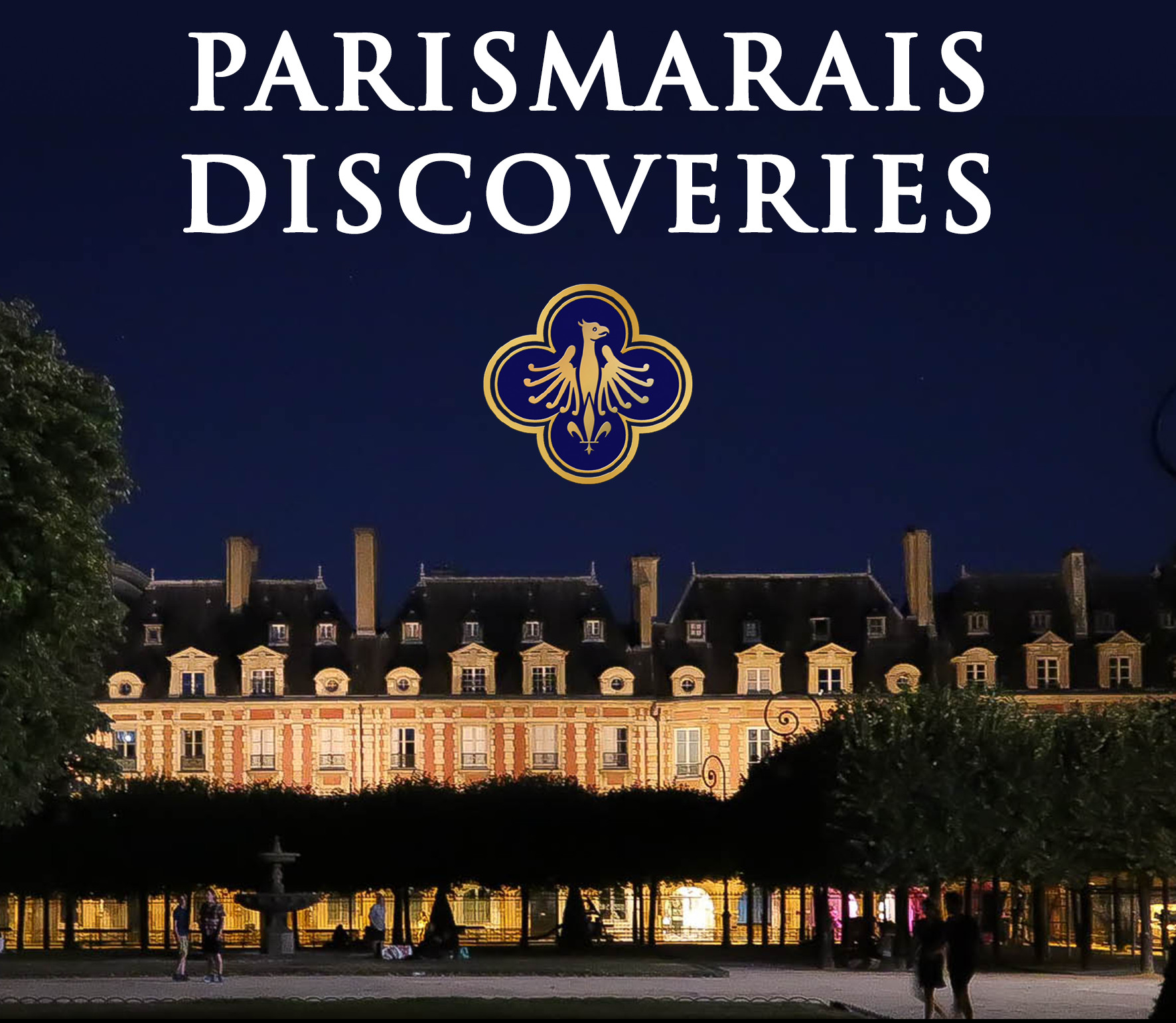
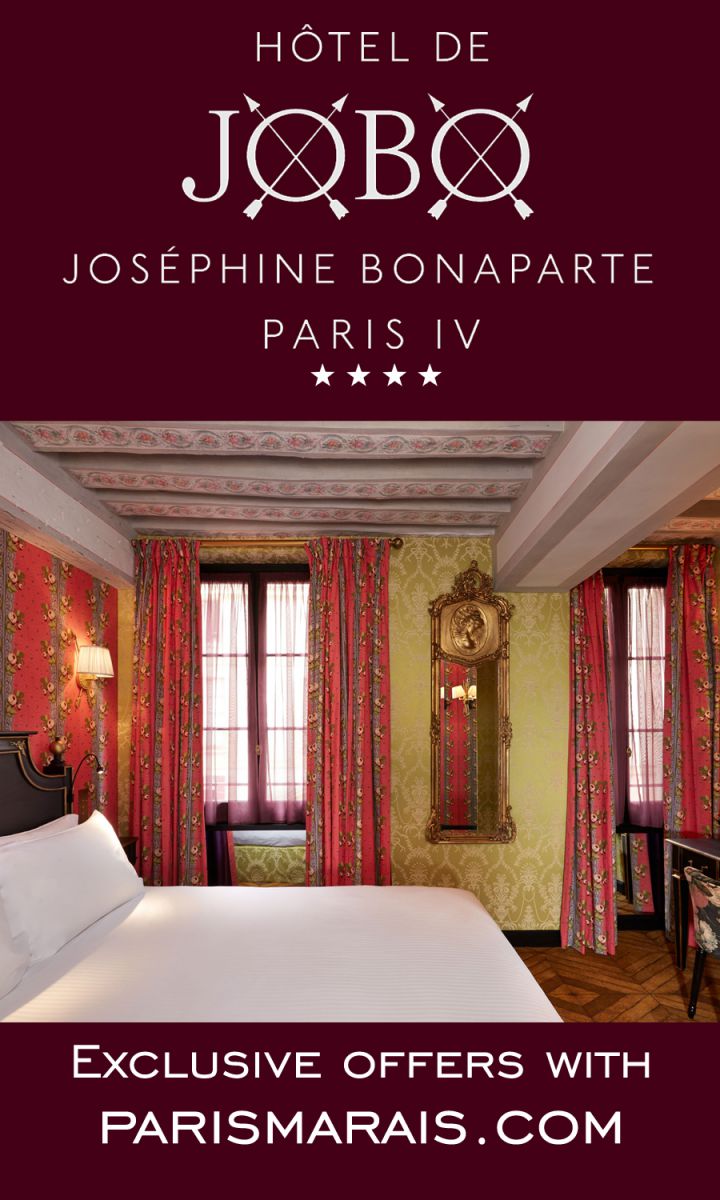
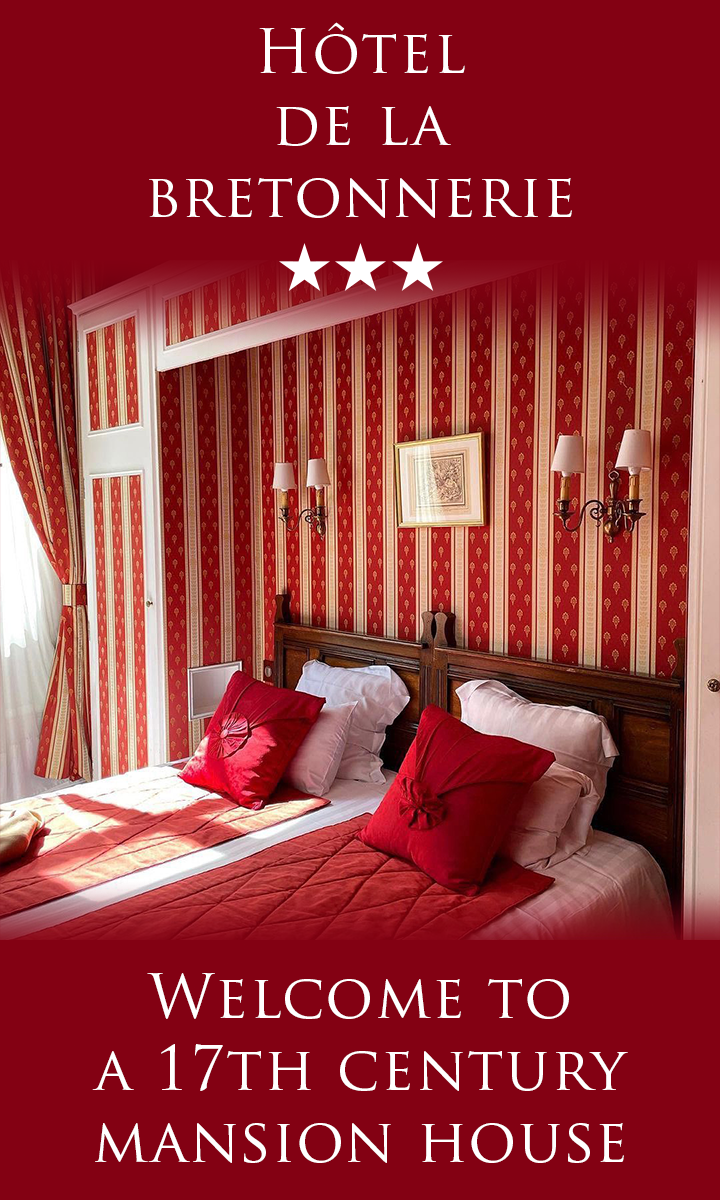
.jpg)
